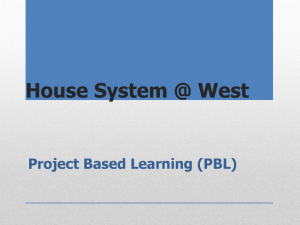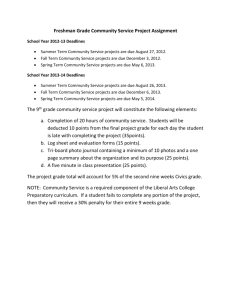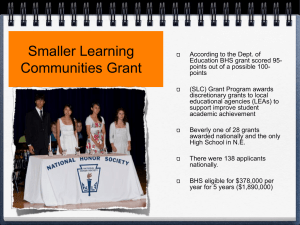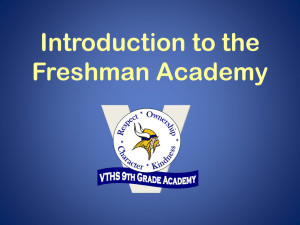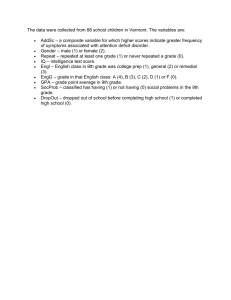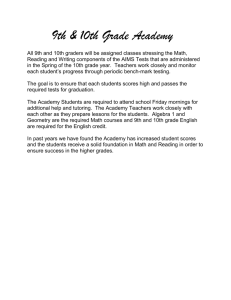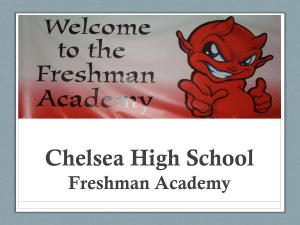Smoothing the Transition between Middle School and High
advertisement
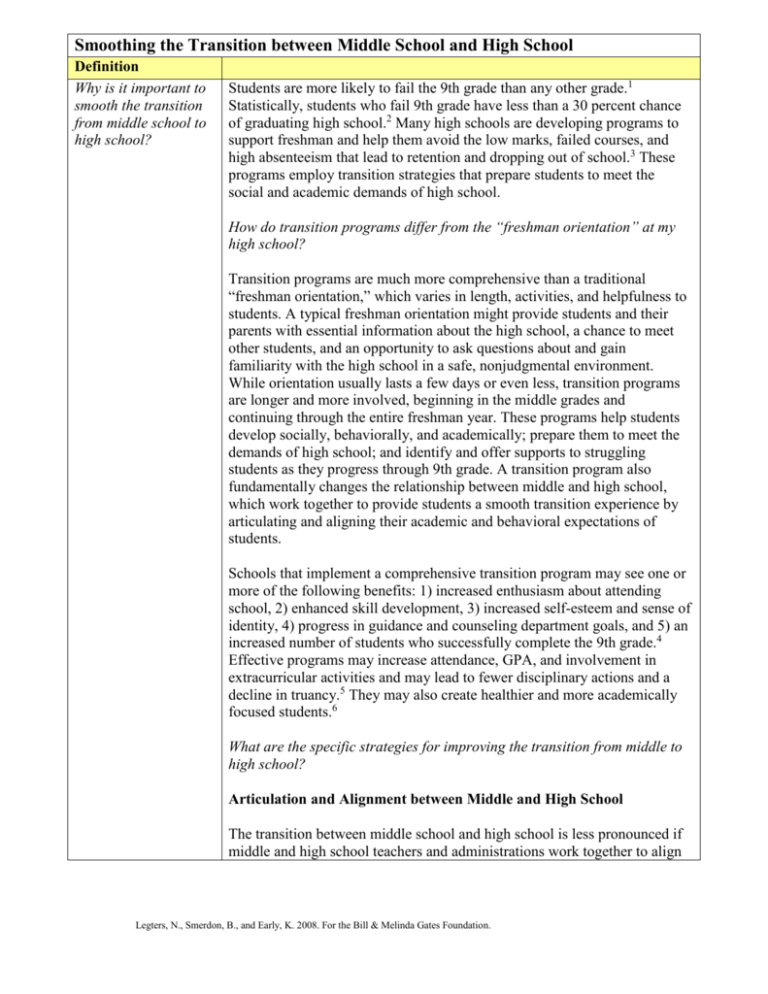
Smoothing the Transition between Middle School and High School Definition Why is it important to smooth the transition from middle school to high school? Students are more likely to fail the 9th grade than any other grade.1 Statistically, students who fail 9th grade have less than a 30 percent chance of graduating high school.2 Many high schools are developing programs to support freshman and help them avoid the low marks, failed courses, and high absenteeism that lead to retention and dropping out of school.3 These programs employ transition strategies that prepare students to meet the social and academic demands of high school. How do transition programs differ from the “freshman orientation” at my high school? Transition programs are much more comprehensive than a traditional “freshman orientation,” which varies in length, activities, and helpfulness to students. A typical freshman orientation might provide students and their parents with essential information about the high school, a chance to meet other students, and an opportunity to ask questions about and gain familiarity with the high school in a safe, nonjudgmental environment. While orientation usually lasts a few days or even less, transition programs are longer and more involved, beginning in the middle grades and continuing through the entire freshman year. These programs help students develop socially, behaviorally, and academically; prepare them to meet the demands of high school; and identify and offer supports to struggling students as they progress through 9th grade. A transition program also fundamentally changes the relationship between middle and high school, which work together to provide students a smooth transition experience by articulating and aligning their academic and behavioral expectations of students. Schools that implement a comprehensive transition program may see one or more of the following benefits: 1) increased enthusiasm about attending school, 2) enhanced skill development, 3) increased self-esteem and sense of identity, 4) progress in guidance and counseling department goals, and 5) an increased number of students who successfully complete the 9th grade.4 Effective programs may increase attendance, GPA, and involvement in extracurricular activities and may lead to fewer disciplinary actions and a decline in truancy.5 They may also create healthier and more academically focused students.6 What are the specific strategies for improving the transition from middle to high school? Articulation and Alignment between Middle and High School The transition between middle school and high school is less pronounced if middle and high school teachers and administrations work together to align Legters, N., Smerdon, B., and Early, K. 2008. For the Bill & Melinda Gates Foundation. courses, expectations of students, rules, and regulations. Some schools use transition teams made up of both middle school and high school teachers to ensure that schools are communicating efficiently.7 For more information on articulation and alignment between grades and schools, see P-16. Using Data to Identify and Support At-Risk Students An early warning system can help identify struggling students before they enter high school so they can be provided with the academic (peer tutoring, double-dosing, etc.), socio-behavioral (counseling), and other supports they need to succeed before they start to fail. Summer Bridge Some high schools have implemented a full “Summer Bridge” program that provides incoming freshman with social and academic experiences that build community and prepare students for 9th grade coursework. It is also a common practice for colleges to offer a summer bridge between the senior year of high school and the first year of college.8 Bridge programs may focus on specific curricula or development of certain skills. They may target historically underserved populations or be offered to all students. The summer bridge is designed to provide students with a gradual introduction to a new school environment to facilitate success. Santa Paula High School (CA) began a “summer jump” program in 1997 to prepare students scoring below the 50th percentile for a college preparatory curriculum.9 Students take classes in reading, writing, mathematics, computer literacy, leadership, and social science, and receive elective credit for their work during the three-week long course. The Chicago Public School District offers a summer bridge program to 3rd, 6th, and 8th graders who did not meet the Iowa Basic Skills minimum test score cutoffs.10 Eighth graders attend class for four hours a day for seven weeks. They work together in small classrooms, which are often staffed with tutors and aides, and study a mandatory curriculum developed by the district. Empirical evidence shows that, on average, 8th grade students who participated in the program made significant academic gains.11 The 8th graders also reported experiencing high academic expectations and personalization during summer bridge.12 Freshman Advisory or Seminar Courses Freshman advisory or seminar courses, typical in colleges and universities, are now being developed for high schools. The idea behind these courses is to prepare students for success in a new environment—to help them develop the skill and knowledge sets they need to meet the expectations of their new school and teachers. Legters, N., Smerdon, B., and Early, K. 2008. For the Bill & Melinda Gates Foundation. For example, 9th grade students in Talent Development High Schools take a course in study skills, note-taking, time management, and social and human relations, among other skills they need to excel.13 The freshman seminar is broken into eight units: “High School Orientation,” “Study Skills,” “Careers,” “College,” “Human Relations,” “Technology and Research,” “Completing a Long-Term Project: Careers Revisited,” and “Social Skills.”14 The curriculum is flexible and modular and may be implemented as a full course, adapted to advisory periods, or integrated into other courses (e.g. social studies). Maine East, a school located outside of Chicago, has a well-developed freshman advisory program. Under the supervision of an adult, trained sophomores, juniors, and seniors work with freshmen, using a planned curriculum designed to increase attachment, achievement, and self awareness.15 South Grand Prairie High School (TX) added a “keystone” transition course for freshmen.16 The first three weeks of the course consist of orientation activities.17 The next six weeks are dedicated to learning communication and other skills.18 Finally, students explore careers and set career and educational goals.19 Toward the end of the program, students have the opportunity to interact with seniors and visit a college.20 Freshman-only Small Learning Communities (a.ka. Freshman Academy) A freshman academy is a small learning community (SLC) designed to improve outcomes for 9th grade students. The freshman academy is one the defining components of Talent Development, a model based at the Everyone Graduates Center at Johns Hopkins University. The Ninth Grade Success Academy has its own physical space to foster a shared kinship and identity among 9th graders and academy adults. Students are taught by interdisciplinary teams of teachers. This structure makes instruction more personalized and aids teachers in identifying, helping, and monitoring struggling students. Additional supports for freshmen provided under the Talent Development model include attendance supports and incentives, flexible block schedules with extended class periods, and double-dosing. Other schools, like Norwich Free Academy, in Connecticut, have begun freshman-only small learning communities to improve student outcomes. Students in Norwich’s “Ninth-Grade House,” are paired with one of five teacher teams. Each teacher team includes an English, civics, math, and science teacher who work together to integrate curriculum and personalize learning for their shared students. Students who struggle in 9th grade despite these added supports are recommended to a special 10th grade SLC, designed to boost these students’ learning.21 Some districts create totally independent schools for freshmen. For instance, Aldine Independent School District in Houston operates four 9th-grade-only schools. Locating 9th graders on separate campuses increases student Legters, N., Smerdon, B., and Early, K. 2008. For the Bill & Melinda Gates Foundation. attachment, comfort-level, and personalization of learning.22 However, students may still need a strong transition program when they leave the 9thgrade only schools and enter 10th grade. Double-Dosing Struggling 9th grade students are assigned to catch-up courses where they receive double the instruction in curriculum areas where they need additional support. See double-dosing for more on this topic. How do innovative schools handle freshman transition? In addition to Talent Development, other models, such as First Things First, National Academy Foundation, America’s Choice, High Schools that Work, and Breaking Ranks have strategies for 9th grade transition. For example, High Schools that Work’s transition program includes an orientation during the middle grades, a summer bridge program, a 9th grade academy for atrisk students (with double-dosing in math and English), career exploratory courses, and a teacher-advisor program to help smooth the transition from middle to high school.23 One of the most innovative strategies used by High Schools that Works is the “No-Zero Policy.” This policy requires that students redo their work until it is no less than C-quality.24 Essential Features The Southern Research Education Board has documented 15 schools’ efforts to smooth the transition from middle to high school.25 These schools use many of the efforts listed above, as well as additional efforts including: extra-time and extra-help programs for struggling students, flexible scheduling, and innovative instructional practices like looping and interdisciplinary learning.26 Preparation for Transition—programming is designed to alleviate students’ fears about moving to a new school and to impart the skills and knowledge necessary for them to successfully negotiate the transition to high school and beyond. Programming is designed with input from teachers and administrators at the high school and middle school levels and begins in middle school.27 Articulation and Alignment between Middle and High School— administrators and teachers at high school and feeder schools work together to articulate and align academic and behavioral expectations of students, and to provide students with the supports they need to meet expectations. Personalization—because high schools tend to be larger and more bureaucratic, they must make an extra effort to create community and recognize students for their individual strengths.28 This can be achieved through a variety of means, including: small learning communities and interdisciplinary teams, freshmen academies, freshman seminars, and personalized learning plans. Programming is designed to help freshmen meet Legters, N., Smerdon, B., and Early, K. 2008. For the Bill & Melinda Gates Foundation. and form bonds with other students29 and teachers. Academic Supports to Close Skill and Knowledge Gaps—students enter high school with different levels and types of preparation (see P-16 systems, for ideas to minimize this effect). Effective transition supports are able to diagnose and address skill and knowledge gaps through double-dosing, tutoring, and other strategies to teach the knowledge, skill sets, and study habits students need in high school. Data system to track student progress—teachers and administrations collect and track student data to look for warning signs that a student is at risk for failure or drop out (for more on this topic, see early warning systems). Once warning signs are spotted, appropriate interventions are taken. Related/Relevant Research and Resources Family Involvement—family members are an integral part of the transition program. (See family involvement module.) Impact of Reform Activities in General Hertzog and Morgan found that schools with more traditional orientation programs (tour of building, registration assistance) experienced the highest dropout and retention rates.30 The researchers recommend schools develop a 9th grade academy to ease transitions.31 They found that schools with a fully implemented freshman academy experienced an 8 percent dropout rate, a third of the dropout rate at comparison schools.32 In addition, fewer students were retained in 9th grade.33 Middle school students enrolled in a “high school transition program with several, diverse articulation activities” were less likely to be retained in a transition grade.34 Successful programs: 1) provided students and parents with information regarding the transition and new school, 2) gave students social support, and 3) required middle and high school-level personnel to cooperate. 35 Program Evaluation The School Transitional Environment Program (STEP), which includes the creation of freshmen SLCs and freshmen homeroom, increased GPA and attendance in 9th grade. Students who participated in STEP had significant positive differences in dropout rate, GPA, and attendance later in their high school career.36 Project Transition, an expansion of STEP, uses student-teacher teams, daily teacher team meetings, and intensive professional development for teachers, including support from a full-time coach. An evaluation by MDRC found that Project Transition improved students’ relationships with classmates and teachers, had a positive effect on student self-perception, and increased engagement and course-passing (findings varied between the two schools studied Legters, N., Smerdon, B., and Early, K. 2008. For the Bill & Melinda Gates Foundation. and in statistical strength).37 Students who attend a Talent Development school (and thus, are enrolled in the model’s signature “Freshman Academy”) are more likely to be promoted to 10th grade, earn more credits, and attend school and graduate at a higher rate than students who attend comparison schools.38 The freshman advisory program implemented at Maine East, and described earlier, decreased the freshman failure rate by 37 percent in the first semester of 2002-03, and by 23 percent in the first semester of 2004-05.39 The 9th grade only centers in Aldine Independent School District, also mentioned earlier, increased attendance, retention, and test scores, and decreased disciplinary problems.40 “Best Practices” A recent study found virtually no differences in outcomes between students who transitioned from middle to high school and students who remain in the same school for both 8th and 9th grades.41 This finding suggests that while outcomes for students change between these two key years, moving from one school to another is not the cause. Interestingly, some students even benefited from the move: in a new environment, some students were able to reinvent themselves and decrease social isolation.42 Start Before Students Begin High School Middle school students have the opportunity to meet and talk to high school students. For example, the school may pair high school students and middle school students in a school-to-school mentoring program. Middle school students should be encouraged to ask the older students questions about high school (e.g., course load, expectations, teaching style, homework, rules). Students have an opportunity to visit the high school before they attend. They are taken on a directed tour and have the opportunity to sit in on one or more classes.43 Middle school students meet with high school counselors before they make course selections. The counselors explain the high school’s policies, procedures, and expectations. The counselors also work oneon-one with students to create a personalized learning plan. The plan takes the student’s high school and postsecondary goals into consideration and covers curriculum and extracurricular activities. Middle School and High School Work Together to Ensure Consistency Teachers and administrators at the high school and middle school work together to develop coherency in curriculum and to gain mutual understanding of course requirements, expectations of students, and policies and procedures.44 See P-16 for more on building consistency between grades and school levels. Provide Extra Supports During the First Few Weeks of High School Ninth graders start school one or more days before the other students, giving them an opportunity to familiarize themselves with the high Legters, N., Smerdon, B., and Early, K. 2008. For the Bill & Melinda Gates Foundation. school (layout, course, expectations) under less stressful circumstances. During the first few months, the school holds activities and events to promote friendships among 9th graders and among 9th graders and other students.45 (Students who feel socially isolated are more likely to drop out.46) Older students mentor or provide tutoring to 9th graders through a well-articulated program.47 Provide Programming Over an Extended Period of Time48 1) Summer Bridge The summer bridge program is taught by teachers who have experience working with 8th grade students and who are knowledgeable about the academic and social demands placed on high school students. Teachers are given adequate time to plan and prepare for the summer session.49 The summer bridge program has its own curriculum, carefully created to help students overcome identified skill deficits through testing and evaluation of student work. The program is designed to prepare 8th graders for the demands of high school.50 Material is paced and taught according to the needs of the students. Summer bridge classes are smaller than classes that meet during the school year, enabling more personalized instruction.51 2) Freshman Seminar or Advisory Although these programs vary in length and format, listed below are essential features they share. The transition program is taught by trained and qualified teachers who care about students and are committed to the program’s goals. 52 The transition program has a comprehensive and fully developed curriculum.53 The transition program is “multi-dimensional,” engaging students in authentic learning through the use of progressive instructional methods (e.g., project-based learning, work-based learning). Students learn more than academics, as teachers also focus on the following:54 Self-Development: The seminar or advisory fosters self esteem and helps students develop their own personal identities.55 Skill Building: The seminar or advisory teaches students the skills they need to succeed in high school (e.g., study skills, time management). Relationship Forming: Activities are designed to help students meet one another. Students are encouraged by their teacher or advisor to join extracurricular activities. Future Planning: Students are required to map out long-term educational, career, and life goals (10 years plus).56 The teacher works with students to make sure they understand what they need to do to reach their goals (e.g., graduate from high school and a four-year university) and that they are taking the necessary steps to succeed (e.g., taking a common core college preparatory Legters, N., Smerdon, B., and Early, K. 2008. For the Bill & Melinda Gates Foundation. curriculum). The transition program and other courses overlap (e.g., students learn about writing an outline in freshman seminar, and are expected to use this method to map out writing projects in their English and history classes).57 The transition program is evaluated for effectiveness yearly and is changed if necessary. 3) Freshman-only Learning Community (a.k.a. Freshman Academy) Also see best practices surrounding SLC. The freshman academy has its own faculty, administrators, and its own space, away from the noise and distraction of the high school.58 Teachers are interested in working with 9th grade students and are prepared to work with this age group.59 The freshman academy is organized into interdisciplinary teams with common planning time. See interdisciplinary teaming for best practices. Successful freshman academies “open strong” by welcoming students on the first day into an organized and inviting learning environment where norms around attendance, behavior, and academic expectations are high, clear, and visible. Academies include students with a range of abilities.60 Academies are small with low teacher-to-student ratios. 61 The freshman academy creates a college-going culture by implementing a common core curriculum. Double-dosing, credit recovery, and other supports are provided as necessary to ensure that all students receive the academic support they need to move on to 10th grade, stay in school, and graduate. Freshman academy administrators and faculty reach out to students’ families and to community members to involve them in academy activities, collectively problem solve around students’ challenges, and communicate and celebrate students’ accomplishments. (See family and community involvement). Freshman academy administrators and faculty meet on a regular basis to troubleshoot and improve academy operations and instructional activities. Freshman academy administrators and faculty receive training and coaching to support strong implementation of academy components and practices. 4) Catch-Up Courses Struggling students are assigned to catch-up courses (See doubledosing). Track Student Progress Data are collected and students’ progress is tracked. Assigned personnel look for “red flags” (e.g., poor grades, course failures). See early warning systems for more information. The early warning system is tied to a multi-tiered intervention system that combines schoolwide prevention strategies to improve student Legters, N., Smerdon, B., and Early, K. 2008. For the Bill & Melinda Gates Foundation. engagement and achievement (e.g., small learning communities and teams, personalized learning plans, advisories, attendance outreach and incentives, report card counseling), with targeted interventions of moderate intensity for small groups of students (e.g., double-dosing), and intensive one-on-one supports as appropriate (e.g., counseling).62 Interventions are sensitive to individual student circumstances, with increasing levels of intensity for those students who are at the greatest risk of dropping out.63 Involve Students’ Family Members While their children are still in middle school, families receive information about the importance of 9th grade to their child’s academic future.64 Families are sent materials that explain the high school’s rules, regulations, and expectations. Materials include important dates that parents/guardians should know and forms they need to read and sign.65 The school holds a family orientation to introduce them to high school policies and procedures.66 During the orientation, speakers identify ways that families can support their children in the transition from middle school to high school and beyond.67 The orientation includes a tour of the school and a question-and-answer session. Families are included in the course selection process. For example, the school may require the parent/guardian to meet with the student and counselor to help develop a personal learning plan or the school may require that at least one parent or guardian review and agree to the student’s course selection.68 Families and students fill out an “opinionaire” form before 9th grade.69 The “opinionaire” helps teachers and administrators get a sense of the values, goals, and opinions of the new students and their families so they can personalize interactions.70 Bottoms, G. (2008). Redesigning the ninth-grade experience: Reduce failure, improve achievement and increase high school graduation rates. Atlanta, GA: Southern Regional Education Board. Retrieved December 15, 2008, from http://www.sreb.org/ publications/2008/08V06_9th-grade_redesign.pdf Campbell, H. (2001). Easing the transition to high school. Education Digest, Sept. 12. Dedmond, R.M., Brown, R.D., & LaFauci, J.M. (2006). Freshman transition programs: Long term and comprehensive. Principals Research Review, 1(4), 1-8. Retrieved August 4, 2008, from http://www.freshmantransition.com /NASSP_ResearchBrief.pdf Dedmond, R.M. (2005). A personalized plan for life. Principal Leadership, 6(3), 16-21. Delisio, Ellen R. (2008). A smooth transition can mean a smooth year. EducationWorld. Retrieved July 18, 2008, from http://www.education-world.com/a_admin/admin/admin321.shtml *Fritzer, P.J. & Herst, P.S. (1996). Make yourself at home: The “house” concept in ninth grade transition. American Secondary Education, 25, 7-9. Legters, N., Smerdon, B., and Early, K. 2008. For the Bill & Melinda Gates Foundation. Herlihey, Corrine. (2007). Toward ensuring a smooth transition into high school. Washington, D.C.: National High School Center. Retrieved July 30, 2008, from www.betterhighschools.org *Herlihey, Corrine. (2007). State and district-level support for successful transitions into high school. In L. Kennely (Ed.), Easing the transition to high school: Research and best practices designed to support high school learning (17-30). Washington, D.C.: National High School Center. Retrieved July 30, 2008, from www.betterhighschools.org Holland, H., & Mazzoli, K. (2001). Where everybody knows your name. Phi Delta Kappan, 83(4), 294-303. Horwitz, A., & Snipes, J. (2008). Supporting successful transitions to high school. Washington, D.C.: Council of Great City Schools. Retrieved December 15, from http://www.sreb.org /publications/2008/08V06_9th-grade_redesign.pdf Kemple, J.J., Herlihey, C.M., & Smith, T.J. (2005). Making progress toward graduation: Evidence from talent development high school model. New York City: NY: MDRC. Retrieved June 25, 2008, from www.mdrc.org *Kezar, A. (2003). Summer bridge programs: Supporting all students. ERIC Digest. Retrieved December 15, 2008, from http://www.ericdigests.org/2001-1/summer.html Klump, J. (2008). What the research says (or doesn’t say): Ninth-grade support systems. Northwest Education, 13(2). Retrieved August 1, 2008, from http://www.nwrel.org/nwedu/1302/research.php/ Lampert, J. (2005). Easing the transition to high school. Education Leadership, 62(7), 61-63. Lindsay, D.M. (1997). Transition from middle school to high school: Worthington Kilbourne high school model. American Secondary Education, 26, 21-25. McIntosh, J., & White, S.H. (2006). Building for freshman success: High schools working as professional learning communities. American Secondary Education, 34(2), 40-49. Mizelle, N.B. (2003). Helping middle school students make the transition into high school. Retrieved July 30, 2008, from http://www.mentalhelp.net/poc/view_doc. php?type=doc&id=2087&cn=28 Mizelle, N.B. & Irvin, J.L. (2000). Transition from middle school into high school. Middle School Journal, 33(5), 1-8. *Neild, R.C., Balfanz, R., & Herzog, L. (2007). An early warning system. Educational Leadership, 65(2), 28-33. *Quint, J.C., Miller, C., Pastor, J.J., & Cytron, R.E. (1999). Project transition: Testing an intervention to help high school freshman succeed. New York: MDRC. Retrieved September 11, 2008, from http://www.mdrc.org/p ublications/72/execsum.html. *Reents, J.N. (2002). Isolating 9th graders. School Administrator, 59(3), 14-20. *Roderick, M., Arney, M., Axelman, M., DaCosta, K., Steiger, C., Stone, S., Villarreal-Sosa, L., & Waxman, E. (1997). Habits hard to break: A new look at truancy in Chicago’s Public High Schools. Chicago, Illinois: School of Social Service Administration, University of Chicago. Legters, N., Smerdon, B., and Early, K. 2008. For the Bill & Melinda Gates Foundation. *Smith, T.J. (2007). Managing the transition to ninth grade in a comprehensive urban high school. Washington, D.C.: National High School Center, AIR. Retrieved September 24, 2008, from www.betterhighschools.org *Southern Regional Education Board. (2002). Opening doors to the future: Preparing lowachieving middle grades students to succeed in high school. Atlanta, GA: Southern Regional Education Board. Retrieved December 15, 2008, from http://www.sreb.org/programs/hstw/ Outstanding/2002_Outstanding_Pract(02V21).pdf Stone, S., Engel, M., Nagaoka, J., & Roderick, M. (2005). Getting it the second time around: Student classroom experience in Chicago’s summer bridge program. Teachers College Record, 107(5), 935-957. Weiss, C.C., & Bearman, P.S. (2007). Fresh starts: Reinvestigating the effects of the transition to high school on student outcomes. American Journal of Education, 133, 395- 421. Williams, E., & Richman, S. (2007). The first year of high school: A quick stats fact sheet. In L. Kennely (Ed.), Easing the transition to high school: Research and best practices designed to support high school learning (1-4). Washington, D.C.: National High School Center. Retrieved July 30, 2008, from www.betterhighschools.org 1 Horwitz and Snipes, 2008. Horwitz and Snipes, 2008. 3 See work by Allensworth, Easton, Balfanz and others. 4 Dedmond et al., 2006. 5 Dedmond et al., 2006. 6 Dedmond et al., 2006. 7 Southern Regional Education Board, 2002. 8 Kezar, 2003. 9 Program described in Delisio, 2008. 10 Stone et al., 2005. 11 Stone et al., 2005. 12 Stone et al., 2005. 13 Description can be found on Talent Development’s website: http://www.csos.jhu.edu/tdhs/pdf/freshman.pdf 14 http://www.csos.jhu.edu/tdhs/pdf/freshman.pdf 15 Lampert, 2005. 16 Southern Regional Education Board, 2002. 17 Southern Regional Education Board, 2002. 18 Southern Regional Education Board, 2002. 19 Southern Regional Education Board, 2002. 20 Southern Regional Education Board, 2002. 21 Campbell, 2001. 22 Kujwa in Reents, 2002. 23 Bottoms, 2008. 24 Bottoms, 2008. 25 Southern Regional Education Board, 2002. 26 Southern Regional Education Board, 2002. 27 Mizelle and Irvin, 2000. 28 Lee and Smith, 2001 found that high schools lead to depersonalization and lack of community. In Herlihey, 2007. 29 Supported in Mizelle and Irvin, 2000. 30 Hertzog and Morgan, 1999, n.d. Dedmond et al., 2006. 31 Hertzog and Morgan discussed in Reents, 2002. 32 Hertzog and Morgan discussed in Reents, 2002. 33 Hertzog and Morgan discussed in Reents, 2002. 2 Legters, N., Smerdon, B., and Early, K. 2008. For the Bill & Melinda Gates Foundation. 34 MacIver, 1990. In Mizelle and Irvin, 2000. MacIver, 1990. In Mizelle and Irvin, 2000. 36 In Quint et al., 1999. 37 Quint et al., 1999. 38 Kemple, Herlihey, and Smith, 2005. 39 Lampert, 2005. 40 Kujawa as quoted in Reents, 2002. 41 Weiss and Bearman, 2007. 42 Weiss and Bearman, 2007. 43 Lindsay, 1997. 44 Mizelle and Irvin, 200. 45 Supported in Mizelle and Irvin, 2000. 46 Lan and Lantheir, 2003. In Horowitz and Snipes, 2008. 47 Used at Maine East. Described in Lampert, 2005. Also mentioned in Fritzer and Herbst, 1996. Research supporting pairing of older-younger students in Mizelle and Irvin, 2005. 48 Dedmond et al., 2006. In Klump, 2008. 49 Bottoms, 2008. 50 Bottoms, 2008. 51 May have been effective in the Chicago Public School District’s Summer Bridge program. Stone, et al., 2005. 52 Dedmond, 2005. 53 Dedmond, 2005. 54 Dedmond et al., 2006. 55 Dedmond et al., 2006. 56 Dedmond, 2005. 57 Dedmond, 2005. 58 Practice used by Talent Development 59 Herzog in Reents, 2002. 60 Suggested in Bottoms, 2008. 61 Suggested in Bottoms, 2008. 62 Bob Balfanz, personal communication. His words. 63 Neild, Curran, and Herzog, 2006. 64 Bottoms, 2008. 65 Program feature in Lindsay, 1997, 66 Mizelle and Irvin, 2000. 67 Mizelle and Irvin, 2000. 68 Supported by research and suggested in Mizelle and Irvin, 2000. 69 Program feature in Lindsay, 1997. 70 Program feature in Lindsay, 1997. 35 Legters, N., Smerdon, B., and Early, K. 2008. For the Bill & Melinda Gates Foundation.
